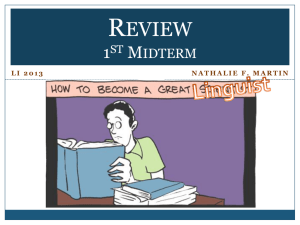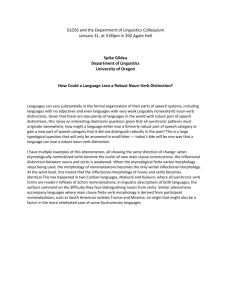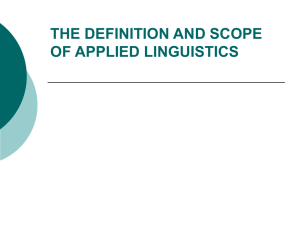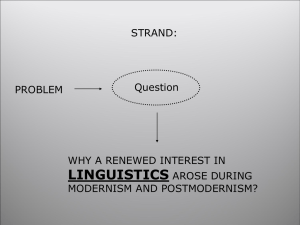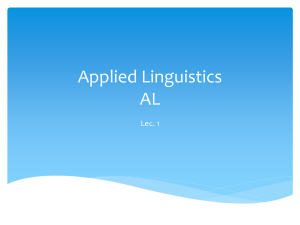MORPHOLOGY - Linguist Sticks
advertisement
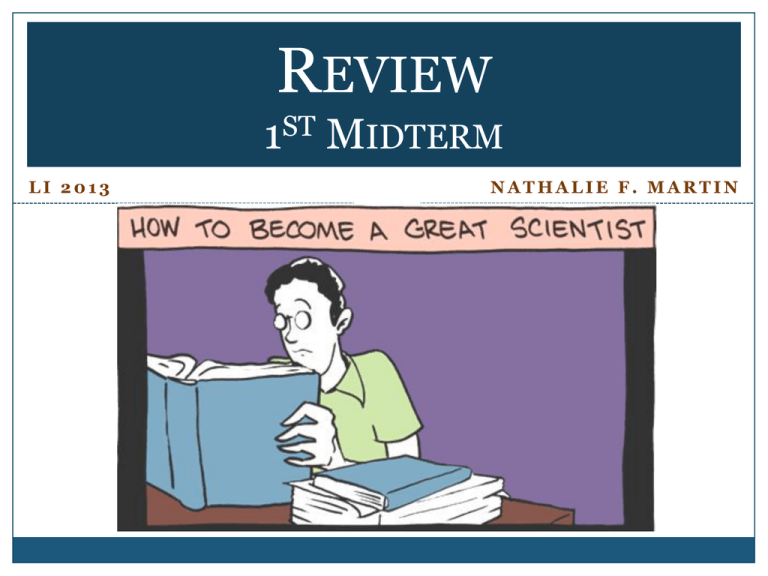
REVIEW 1ST MIDTERM LI 2013 NATHALIE F. MARTIN On the Exam ... Here is what will be on the exam: Language: A Preview (chap. 1, O’Grady) Fields of linguistics (handout and Powerpoint) Phonetics (brief introduction done in class) Morphology (chap. 4, O’Grady) ... In short, what we saw in class What you should know: MORPHOLOGY (chap. 4, O’Grady) Def: Morphology Morphemes: Free, bound morphemes Allomorphs Analysing Word Structure Root, affix Base Affix: prefix, suffix, infixes Derivation: English derivational affixes Complex derivation Constraints in derivation Two classes of derivational affixes What you should know: MORPHOLOGY (continued) Inflection: Inflections in English Inflection vs. Derivation (chap. 4, O’Grady) Compounding: Properties of compounds Endocentric and exocentric compounds Compounding in other languages Other Morphological Phenomenon: Processes: Internal change, suppletion, reduplication, tone placement / cliticization, conversion, clipping, blends, backformation, acronyms, onomatopoeia, etc. Correction of last week’s homework Exercise 9 (see p. 117) a) b) Correction of last week’s homework Exercise 9 c) Correction of last week’s homework Exercise 13 a) Inflectional b) Derivational c) Inflectional* → lovely, lovelier, loveliest (p. 125) d) Inflectional e) Derivation Morphology Invent a word using this root : VACUUM 1. 2. 3. 4. by adding a prefix to this base (make sure that there are no constrains to the combination). And then adding a suffix. Draw the structure (tree) of the two words that you have just created. What are the lexical categories of these words? What you should know: LANGUAGE: AN INTRODUCTION (chap. 1, O’Grady) How humans are made to speak What is language Linguistic competence vs. performance Descriptive vs. Prescriptive approach to language Grammar: Generality, parity, universality, mutability, inaccessibility Things you should know … What is language? Definiti0n: language, languages and speech Linguistic competence vs. performance 1.1 Specialization for Language Contemporary Linguistics Analysis: p. 2. Organ Survival Speech Lungs Exchange CO2 for O2 Air flow Vocal Cords Cover tube to lungs Vibration Tongue Move food in mouth Articulation Teeth Chew food Articulation Lips Seal oral cavity Articulation Nose Breathing Nasal resonance Descriptive or Prescriptive? Newfoundland English retains distinct morphology brought in by the original settlers (e.g. « I goes », « you goes » and « all the people goes »). It is not proper to use double negatives (e.g. I don’t have nothing). Grammar, as seen through Linguist’s eyes ... Generality: All languages have a Parity: grammar All grammars are equal Universality: Grammars are alike in Mutability: Inaccessibility: basic ways Grammars change over time Grammatical knowledge is subconscious What you should know: FIELDS OF LINGUISTICS (handout and Powerpoint) Linguistics Fields of linguistics (handout and Powerpoint) Descriptive linguistics Applied linguistics EARLY DAYS OF THE STUDY OF LANGUAGE Philology Historical linguistics Comparative linguistics Objet: ancient civilisations Objet: language(s) and it’s/their evolution Objet: comparison between languages FIELDS OF LINGUISTICS ________________ ________________ Phonology Sociolinguistics Morphology Psycholinguistics Syntax Neurolinguistics Semantics Computational Pragmatics linguistics PHONETICS: A Brief Introduction (Handout and Powerpoint) What you should know: Introduction to phonetics Sounds of English Consonants & vowels IPA chart (general) Transcription IPA Consonants Chart IPA Vowel Chart IPA Glides (examples) Phonetic Practice 1. Read these words phonetically and write them out using conventional English spelling. [mit] [ ʃuz] [skul] [mju zɪk] 2. Fill in the missing symbols. Cartoons = [ _ ɑ _ _ u _ _ ] Singing = [ _ ɪ _ ɪ _ ] English = [ɪ_ _ _ ɪ_] Cheese = [_ _ _ _ ] HAVE A NICE DAY! God bless you! “Now to him who is able to keep you from stumbling and to present you blameless before the presence of his glory with great joy, to the only God, our Savior, through Jesus Christ our Lord, be glory, majesty, dominion, and authority, before all time and now and forever. Amen.” (Jud 1:24-25 )
